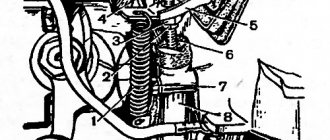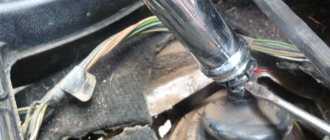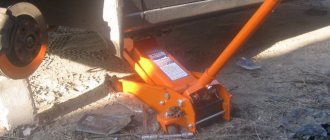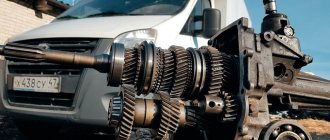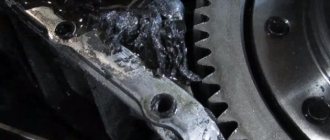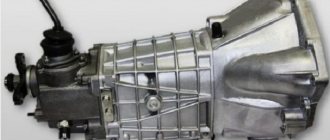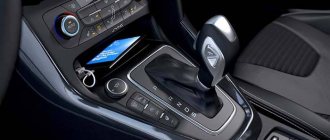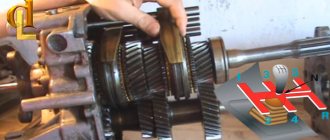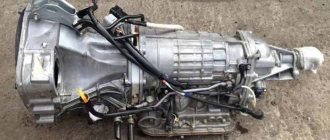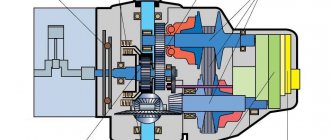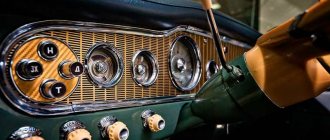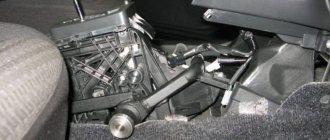How does a gearbox synchronizer work? A new question, and for some a new term - synchronizer.
Yes, friends, there were times when changing gears in a car was a complex process, and, one might say, almost a jewel.
But, thanks to human laziness, which is the engine of progress, we got cars that do not require unnecessary actions on the part of the driver and simplify the driving process in every possible way.
And we will not even talk about fashionable automatic transmissions, but about old, time-tested “mechanics”. To make our driving life easier, in those “pre-automatic times” a gearbox synchronizer was invented.
In this article we are going to find out how it works, how it is structured and what generally happens when switching gears.
Synchronizer design
The synchronizer consists of the following elements:
- hub with breadcrumbs;
- engagement clutch;
- locking rings;
- gear with friction cone.
Synchronizer device
The basis of the unit is a hub having internal and external splines. With the help of the former, it is connected to the gearbox shaft, moving along it in different directions. Using external splines, the hub is connected to the coupling.
The hub has three grooves located at an angle of 120 degrees relative to each other. The grooves contain spring-loaded nuts that help fix the clutch in the neutral position, that is, at a time when the synchronizer is not working.
The coupling serves to provide a rigid connection between the gearbox shaft and gear. It is located on the hub, and from the outside it is connected to the gearbox fork. The synchronizer locking ring is necessary to synchronize the rotation speed using friction; it prevents the clutch from closing until the shaft and gear are at the same speed.
We recommend: Installation and replacement of the fuel pump relay
Operating principle of the gearbox synchronizer
Scheme of operation of the synchronizer
When the clutch is turned off, it occupies the middle position, and the gears rotate freely on the shaft. In this case, no torque transmission occurs. In the process of selecting a gear, the fork moves the clutch towards the gear, and the clutch, in turn, moves the locking ring. The ring is pressed against the gear cone and rotates, making further advancement of the clutch impossible.
Under the influence of friction, the speeds of the gear and shaft are synchronized. The clutch moves freely further and rigidly connects the gear and gearbox shaft. The transmission of torque begins and the vehicle moves at the selected speed.
Despite the rather complex structure of the node, the synchronization algorithm lasts only a few fractions of seconds.
Synchronized gearboxes, what does this mean?
Nowadays, virtually all mechanical and robotic boxes are synchronized. To turn on the speed in boxes of this type, a necessary condition is to equalize the rotation speed of the gear and shaft. Synchronization is provided by a device called a synchronizer. In addition to smooth gear shifting, it can reduce noise when changing gears, reduce wear on the mechanical connection and thereby increase the service life of the gearbox. All transmission gears of a passenger vehicle, including reverse gear, are equipped with synchronizers.
Malfunctions and replacement issues
When it comes to malfunctions in the operation of the gearbox, experienced motorists and experts in the field of gearbox repair recommend starting checks and diagnostics with the condition of the clutch assembly. If everything turned out to be in order there and there are no problems, you can already check the synchronizers directly related to gear shifting on the car.
The only question is how to do this and what makes it possible to verify gearbox malfunctions related directly to the synchronizers.
To check the functionality of the synchronizer, you should rely on several characteristic signs that indicate problems with this unit.
- Noise that appears during the operation of the gearbox. Uncharacteristic noise and unpleasant sound may be due to the fact that the blocking rings have become deformed and bent. This happens quite often if problems are discovered in the gearbox. But it also cannot be ruled out that the cause of the noise was a worn cone;
- The gears switch off spontaneously, and the driver has nothing to do with it. Spontaneous switching off of the speed on the box certainly indicates that the problems are related to the clutch. An alternative option is wear of the gear life. She can no longer cope with the tasks assigned to her and needs to be replaced as soon as possible;
- The gears are engaged with a certain effort. Sometimes you have to apply quite a lot of force, which is uncharacteristic of a gearbox, to engage a different speed. This is a direct sign of complete wear of the synchronizer, which is no longer suitable for further operation.
It is important to consider that repairing a unit such as a box synchronizer is a very labor-intensive process. Often, carrying out such repair and restoration activities is completely unjustified. In rare cases, repairs are resorted to. Objectively, the simplest and most financially justified solution is to replace the unit. All you need to do is dismantle the old synchronizer, first making sure that all the problems are caused by it, and then install a new mechanism.
The entire replacement process looks like this:
- First, the gearbox itself is removed from the car. At the same time, it is recommended to completely clean it, remove all contaminants and prepare it for further work;
- Then the cable bracket of the box clutch assembly is dismantled. Here you will first have to unscrew the fastening nuts that hold the cover in place, and then remove the cover itself;
- The next step is to remove the mounting bolt from the fifth gear fork. You need to enable it. To do this, the synchronizer clutch together with the fork moves down;
- This procedure is done consistently and carefully. It is important here that the coupling splines engage with the gear;
- Having completed this procedure, you will need to engage 3rd or 4th gear on the box;
- Then the fastening nut holding the input shaft is removed;
- To move the nut even slightly from its dead point, an impressive amount of force will be required. This is due to the fact that this nut is initially tightened with a large torque;
- A similar procedure is performed with the fastening nut, which already holds the secondary shaft;
- As a result, all that remains is to slightly lift the driven gear at 5th gear, while grabbing the secondary shaft fork and synchronizer, and remove the assembly.
All work is carried out under close control of the coupling. This should not be allowed to come off the hub during the replacement process.
Installation of the new mechanism is carried out strictly in the reverse order of the dismantling procedure. If you have any difficulties or doubts about replacing the synchronizer yourself, it is better not to risk it and entrust the work to specialists. The event is responsible and quite complex. In some places it is better to use special tools. Not everyone can unscrew the same fastening nut, tightened with a huge torque. Plus it will need to be tightened again with the same torque. And here you can’t do without a torque wrench of good quality and sufficient power.
Preventive actions
Synchronizers do not belong to the category of mechanisms that fail with enviable regularity and require constant attention, repair or replacement.
But if we take into account the fact that the replacement procedure is quite labor-intensive, requires certain skills from the car owner, or additional financial costs for paying for the services of car service specialists, a more correct solution would be to extend the service life of the unit.
In order for the synchronizer to work for a long time, efficiently and effectively, you need to follow literally a few simple rules.
- Minimal use in aggressive conditions. Try to avoid aggressive driving. Do not try to constantly start abruptly, brake and accelerate again, literally tearing apart the gearbox. Smooth and moderate control of the gearbox will significantly increase the already quite impressive life of the synchronizers.
- Do not forget about the correct correspondence between the speed of the vehicle and the selected gear on the gearbox selector. Each gear has its own specific and optimal speed range for the machine. This is taught in the first lessons at a driving school. And such information should be remembered very carefully. If the speed matches the gear, and the gear speed, then the optimal load will begin to affect the synchronizers. This will have a positive effect on the service life of the mechanism and will significantly delay the replacement of the synchronizer on your car.
- In accordance with the regulations and requirements of the car manufacturer, carry out maintenance of the box. Often, the recommendations in the instructions for foreign cars do not quite coincide with the actual mileage and timing in relation to our operating conditions. Therefore, from the mileage indicated in the manual to the replacement of the same transmission oil or other consumables, it is usually recommended to subtract 15-25%. This means that maintenance needs to be done a little earlier. It all depends on the conditions under which the car and the gearbox in particular are operated.
- Use suitable oils for the box. Here again you need to look at the instruction manual. Manufacturers clearly state which transmission oils should be used for your specific transmission. It is better not to deviate from these recommendations. If you cannot find or purchase oils of the specified brand with the recommended characteristics, look among other manufacturers of working fluids for compositions that are as close as possible to the properties of the original oil.
- Before changing gear, be sure to fully depress the clutch pedal. Some drivers do not press the pedal all the way, as a result of which a large load begins to affect the synchronizer and wear accelerates. Regular operation of the clutch pedal in this manner will lead to breakdowns and malfunctions. By following this simple rule, you will be able to avoid unnecessary problems.
The synchronizer is truly a useful and effective addition to the design of modern mechanical and robotic gearboxes.
The vast majority of gearboxes installed on modern cars are synchronized. This is a completely justified and correct move on the part of the manufacturers. The unit has wide functionality, while simultaneously extending the service life of the entire box.
Gearbox synchronizer
It must be said that the gearbox synchronizer is not the simplest device, although it does not have a single drop of electronics, and its response time takes a fraction of a second.
In the old days, to change gears in a car, it was necessary to squeeze the clutch several times - one press disconnected the box from the crankshaft, and the second, on the contrary, connected it back.
It is clear that such a procedure is not very convenient and it was necessary to get rid of it somehow. Physics, mechanics and precise engineering calculations helped, in the symbiosis of which the synchronizer was born.
It is necessary to equalize the rotation speed of the shaft and gears, so that switching occurs accurately and without unnecessary noise.
In short, the gearbox synchronizer made life easier for drivers, and also significantly increased the service life of the gearbox mechanisms. They are installed, synchronizers, for each gear, sometimes for reverse.
Manual transmission synchronizers
The synchronizer is necessary for silent and smooth operation of the manual transmission.
Gear shifting in a manual transmission is ensured by a set of gears that mesh in pairs. In this case, one gear of the pair is rigidly fixed to the input shaft, and the second, which has the ability to rotate, is located on the intermediate shaft of the box. The driver, moving the manual transmission control lever, engages first one pair of gears, then the other. Since the diameters of the gears are different, when pairs are formed, the gear ratio changes, which ensures stepwise adjustment of the vehicle speed. With different diameters, gears also have different numbers of teeth. Therefore, in order to be able to change pairs involving different gears without stopping the car, a design was invented, part of which is a synchronizer.
What is a synchronizer
To connect the gears, the manual transmission design provides movable couplings that “push” the gears towards each other. However, to achieve engagement of the rotating wheels, it is not enough to bring them closer together - it is necessary to ensure that they rotate at the same speed. Only after this the teeth will engage without noise and the first time. To equalize the speeds, an interesting technical solution was invented and implemented: the end of the gear that needs to be engaged is given the shape of a cone, and a special ring with a gear ring is placed between it and the clutch, which is called a manual transmission synchronizer.
What work does a synchronizer do?
The clutch, approaching the gear that needs to be engaged, first comes into contact with the synchronizer. As you move further, the clutch presses it against the wheel. Friction arises, and the gear begins to accelerate (if it was rotating slower than the clutch), or slows down until the rotation speeds equalize. When this effect is achieved, all three elements are motionless relative to each other, and they can be linked. The clutch continues to move forward and presses on the gear, pushing it towards another gear on another shaft with which it must engage.
The emergence of synchronized gearboxes
In the USSR, all pre-war models (GAZ-A, GAZ-M-1) and some post-war cars (Pobeda GAZ-M-20 of the first releases, GAZ-69 SUVs) were equipped with non-synchronized manual transmissions. Synchronizers, and with them synchronized gearboxes, began to appear in the forties. At the same time, at first only higher gears were equipped with synchronizers - for example, second and third in the GAZ-21 Volga design. It was believed that at a low speed, any driver would be able to guess the moment of downshifting with a certain skill.
What are synchronizers made of?
Most often, synchronizers are made of brass or steel. Metal rings are formed either by forging or using a powerful press. In this case, the gear rims can be coated with a protective coating of molybdenum, iron, and copper. In modern gearboxes there are synchronizers covered with a layer of carbon fiber. The purpose of the coating is to reduce noise and provide high friction when in contact with the gear. Carbon coated rings offer excellent performance, but are quite expensive to produce, so such parts are only found in the transmissions of high-end sports cars.
Interesting facts about synchronizers
Transmissions without synchronizers are still used in some motorsport vehicles. In particular, some rally manual transmissions are not synchronized, since the simplicity of the design always leaves a chance to reach the finish line when other cars have already left the race. As for the ability to change gears, an experienced athlete operates a non-synchronized gearbox even faster than a synchronized one.
Purpose of the synchronizer
General view of the synchronizer
We recommend: Which ignition is better - early or late?
All gears of modern passenger car transmissions, including reverse gear, are equipped with a synchronizer. Its purpose is as follows: to ensure equalization of the rotation speed of the shaft and gear, which is a prerequisite for shock-free gear shifting.
The synchronizer not only ensures smooth gear shifting, but also helps reduce noise levels. Thanks to the element, the degree of physical wear of the mechanical parts of the box is reduced, which, in turn, affects the service life of the entire gearbox.
In addition, the synchronizer simplified the principle of gear shifting, making it more convenient for the driver. Before the advent of this mechanism, gear shifting occurred by double squeezing the clutch and shifting the gearbox to neutral.
Repair of a manual gearbox (MT)
| Name of works | Domestic cars: | Foreign cars: |
| REPLACEMENT: | ||
| — Clutches | from 2,700 rub. | from 3,700 rub. |
| — Synchronizer | from 14,000 rub. | from 18,000 rub. |
| Removal and installation of manual transmission | from 2,500 rub. | from 3,500 rub. |
| Manual transmission repair | from 12,000 rub. | |
The most common damage to this unit are:
- Wear of its parts (gears, couplings, splines, bearings, seals);
- Lowering the oil level in the box;
- Loosening or cutting of threads in various joints of the assembly.
The reasons for the above breakdowns are, first of all, incorrect operation of the units, natural wear due to a long service life, low-quality components and illiterate maintenance of this unit.
Synchronizer malfunctions and ways to eliminate them
If any difficulties arise with shifting gears, most car owners who have at least basic knowledge about the structure and principle of operation of the gearbox believe that the synchronizer is to blame. This often turns out to be true, although you should first rule out clutch malfunctions, which also quite often cause problems in the operation of a manual transmission when the system operates with jamming, a certain delay, and so on.
If the check does not reveal any violations, you can independently suspect problems with the synchronizer based on the following symptoms:
- When the gears switch off spontaneously, first of all, you need to pay attention to the release clutch and gears, which may be worn out.
- If, when switching gears, a noise appears, the identification of which is impossible and which was previously uncharacteristic, this may indicate that the locking ring is bent or that its conical part is worn out.
- Difficult gear shifting, when it is necessary to make a lot of effort and make several attempts, is virtually guaranteed to indicate a failed synchronizer.
It should be said right away that repairing this device is extremely labor-intensive and virtually impossible to do it yourself. This will require professional equipment and a lot of time, so it is advisable to entrust this matter to specialists. In addition, it is worth knowing that quite often a phenomenon such as chipping of gear teeth can be observed - owners of trucks and those who like sudden starts from a standstill are most susceptible to this danger. Operation of such a box is unacceptable.
Synchronizer resource
In case of any malfunctions related to gear shifting, it is first necessary to rule out problems with the clutch and only then check the synchronizer.
You can independently identify a unit malfunction using the following signs:
- Noise when the gearbox is running. This may indicate that the locking ring is bent or that the cone is worn out.
- Spontaneous gear shutdown. This problem can be associated with the clutch, or with the fact that the gear has outlived its service life.
- Difficulty engaging the gear. This directly indicates that the synchronizer has become unusable.
Repairing a synchronizer is a very labor-intensive process. It is better to simply replace the worn mechanism with a new one.
Compliance with the following rules will help extend the service life of the synchronizer and gearbox as a whole:
- Avoid aggressive driving style and sudden starts.
- Select the correct speed and gear.
- Carry out gearbox maintenance in a timely manner.
- Timely change the oil intended specifically for this type of gearbox.
- Fully depress the clutch before changing gears.
Purpose and device
The gearbox is designed for several tasks:
- torque changes,
- speed changes,
- correcting the direction of movement of the car,
- disconnecting the internal combustion engine and transmission and, on the contrary, connecting them (this need is relevant when changing gears, the need to obtain low “creeping” speeds, and short-term stopping of the vehicle),
- locking the torque converter (the function is valuable for reducing the loss of useful energy of the “automatic” when transmitting torque in a situation where the speed of the driven and driving turbines is equalized).
At the same time, some gearboxes are capable of solving all these problems, while others, such as a mechanical one, only do the basics - changing torque and speed.
The design of the device depends on the type of gearbox. The housing of the gearbox with “mechanics” combines shafts (2, 3 or more), a synchronizer, gears, a gear shift lever, wire rings, bearings, and oil seals.
The automatic transmission device (gearbox with “automatic”) is a unit that includes a torque converter, planetary gear, clutches, brake band, control unit (pump + oil sump + valve box).
Robotic gearboxes can be based on either mechanical solutions with an electric or hydraulic clutch and gear control system, or automatic gearboxes equipped with an electro-hydraulic clutch drive.
Let's look at the clutch, gears, shafts and synchronizers in more detail.
Clutch
Designed to transmit torque from the flywheel of the internal combustion engine crankshaft to the input shaft of the gearbox.
It is thanks to the presence of the clutch that the engine can be carefully disconnected from the transmission for a short period of time, and the transmission can be protected from overloads.
The standard clutch on most manual transmission vehicles includes the flywheel, pressure plate, driven plate, throwout bearing, drive, fork, and clutch switch.
One engine is connected to the wheels, the other to the internal combustion engine. The moment the driver releases the pedal, the discs are pressed against each other and begin to rotate together.
It is the classic clutch as such that is most often talked about when using a manual transmission, and when driving with an internal combustion engine on an automatic transmission they talk about a combined solution of the clutch and torque converter. Its immediate function is similar to that of a clutch. But the driver does not need to perform any routine actions and press the clutch manually. The checkpoint itself will do everything for him.
As for robotic solutions such as DSG (with mechatronics), they have two clutches. The presence of two clutches is valuable for increasing the power of the vehicle, while minimizing slippage and optimizing fuel consumption.
Indeed, physically, at the moment of switching, the engine speed when using two clutches can remain at the same level.
In the picture below you see the “behavior” of the clutch in the DSG robotic gearbox at the moment after switching to second gear.
Gears and shafts
Gears and shafts are the main “controllers” of torque.
It is the gears and shafts that help change the gear ratio. Integral elements of all manual transmissions and some automatic transmissions (for example, Honda). The design of a manual transmission is most often designed so that the shaft axes are in a parallel plane. Gears are mounted on top.
The primary or drive shaft (pedal shaft) is connected to the flywheel through the clutch basket. The lugs help advance the second clutch disc and direct torque to the intermediate shaft through the gear.
The end of the secondary shaft is adjacent to the bearing on the drive shaft. Since there is no fixed connection, the shafts are independent and there is no obstacle to them rotating in different directions. There are no obstacles to varying speeds.
The design of an automatic transmission involves a planetary gearbox instead of gears and shafts. Gears and shafts always rotate as a single unit. But structurally it can be either different parts or a non-separable unit.
Synchronizers
Synchronizers are an integral element of a gearbox with gears - except for solutions with sliding gears.
Physically, the work of synchronizers is due to the force of friction. The function of synchronizers is to equalize the rotation speed of gears and shafts, thereby creating all the conditions for smooth gear shifting. Thanks to synchronizers, the gearbox wears out less and makes less noise.
Synchronizers are actively present in manual transmissions and robotic gearboxes. For cars with planetary automatic transmissions, an alternative to synchronizers is friction control elements. Synchronizers consist of a clutch, locking rings, a retaining ring, a spring, and gears.
How does a standard synchronizer work?
- The clutch is fed towards the gear.
- The clutch locking ring absorbs the force.
- The tooth surfaces begin to interact.
- The locking one acquires the position “on the stop”.
- The teeth of the coupling are opposite the teeth of the locking ring.
- The clutch engages with the ring gear.
- The clutch and gear are blocked.
It would seem that there are quite a lot of steps, but all this happens in a fraction of seconds - at the moment the driver engages the gear.
Operating principle of manual gearboxes
Transmissions with “mechanics” use various combinations of gears during operation.
The operating principle of a manual transmission is based on creating connections between the primary and secondary shafts. Thanks to the use of gears with different numbers of teeth, the transmission adapts to the conditions on the road and the driver's goals.
As the speed of rotation of the output shaft of a manual transmission increases relative to the speed of rotation of the input shaft, the amount of torque from the internal combustion engine to the wheelbase decreases.
When the speed of rotation of the output shaft of the manual transmission decreases in relation to the speed of rotation of the input shaft, the amount of torque from the engine to the drive wheels, on the contrary, increases.
Gearboxes vary in the number of stages. Each stage has its own gear ratio. It represents the ratio of the number of teeth of the driven gear to the number of teeth of the drive gear.
A low gear has the highest gear ratio, and a high gear, on the contrary, has the smallest gear ratio. The lower the gear ratios, the faster the vehicle can accelerate.
When gear ratios and vehicle speed change, the clutch is used to momentarily disengage the transmission.
Depending on the design of the gearbox, it can be two-shaft or three-shaft. Both the device and the operating process of the units are somewhat different.
2-shaft gearbox: device and principle of operation
Twin-shaft solutions are very popular on front-wheel drive cars. The design includes the following elements:
- crankcase – load-bearing element, housing. All other parts of the device are attached to it. It also protects the unit from external influences, and a person from rotating parts, and also serves as a storage facility for oil.
- shafts – primary and secondary,
- gears (in blocks), part is attached to the drive shaft, part to the driven shaft,
- spline (connects PV and clutch),
- synchronizers.
Important!
The main gear and differential are also located inside the crankcase, but the gear shift mechanism is located outside it.
The shift lever is in the neutral position: the gears rotate, the torque from the internal combustion engine is not transmitted to the wheels.
The lever is moved - the synchronizer clutch also changes position. The angular velocities of the corresponding shaft and gear are equalized. Torque is transmitted from the primary shaft to the secondary shaft. Torque is transmitted from the internal combustion engine to the drive wheels with a given gear ratio.
The picture shows the reverse gear separately. For him, the gearbox has a reverse gear. The idler gear is used to correct the direction. It is mounted on a separate axle.
3-shaft gearbox: design and principle of operation
3-shaft solutions are popular in rear-wheel drive cars.
Device:
- Carter.
- Vedval.
- Driven shaft. Located on the same axis with the driving one.
- Intermediate shaft. Mounted parallel to the primary.
- Gears. The driven shaft gear unit rotates freely on it. The gear block of the intermediate and driven shafts is provided with a rigid connection, and the gears on the driven shaft rotate freely, there is no clear fixation.
- Synchronizers. They stay in all gears. Thanks to the slot, they move freely in the longitudinal direction.
- Switching mechanism (lever + sliders + blocker). Mounted on the crankcase.
The system functions similarly to a two-shaft system, but due to the presence of an intermediate shaft there are more possibilities.
The input shaft works in tandem with the clutch and is responsible for transmitting torque to the intermediate shaft. All parts are in engagement. The fundamental difference is that there are fewer friction losses during the first gear and the ability to ensure the engagement of two pairs of gears at once. Accordingly, the solution has a higher efficiency in first gear.
Why is it necessary to use a synchronizer?
The essence of the operation of a mechanical gearbox is to ensure a rigid connection between the gear, which initially rotates freely on the shaft, and the splines made on it at the moment the next gear is engaged. But the very nature of gearing requires the relative immobility of the teeth included in the connection. Otherwise, a series of hard impacts is possible, causing noise, jerking and damage to parts due to peak shock loads.
For shock-free switching on, as well as ensuring reliable operation under alternating loads, a number of conditions must be met:
- the relative speed of movement of the teeth must be reduced to zero, that is, in this case the gear must be stopped relative to the shaft;
- the entrance part of the teeth must be made with sharp points, since there is a possibility of an exact hit of tooth on tooth, which will not allow you to switch;
- a latch is required, that is, a device that causes resistance when attempting to disengage due to vibration or the longitudinal component of the transmitted force.
Previously, the driver had to independently level the speeds of the gears, which required the ability to shift with double clutch release and intermediate throttling. This required considerable skill and time to move down the gears. Nowadays, some of the problems are alleviated by the presence of a synchronizer, although re-throttle is sometimes used, for example, in sports and on powerful cars.
Replacing a synchronizer in a manual transmission
To replace the synchronizer in a manual transmission, you will have to remove the gearbox from the car and completely disassemble it, after draining the oil. The synchronizer replacement process is performed in the following order.
- Clean the manual transmission housing from dirt.
- Remove the bracket for the clutch cable.
- Remove the cover by unscrewing the fastening nuts.
- Remove the fork bolt and move the clutch down so that its splines remain engaged with the gear.
- Engage top gear.
- Remove the input shaft fasteners. This will require quite serious physical effort.
- Release the secondary shaft in the same way.
- Lift the gear and remove it as one unit with the synchronizer and fork. In this case, the coupling should not come off the hub. It is advisable to mark the position of the coupling with chalk or a pencil.
- Remove the synchronizer, install a new part, and treat it with lubricant.
- Reassemble the gearbox in the reverse order of disassembly.
If everything is done correctly, the problem is resolved by replacing the synchronizer. However, inexperienced car owners are not recommended to perform the replacement themselves, as errors in the assembly may lead to the need to replace the entire gearbox. Contact the specialized service mkpp-remont.ru - experienced craftsmen will carry out repairs within one day.
